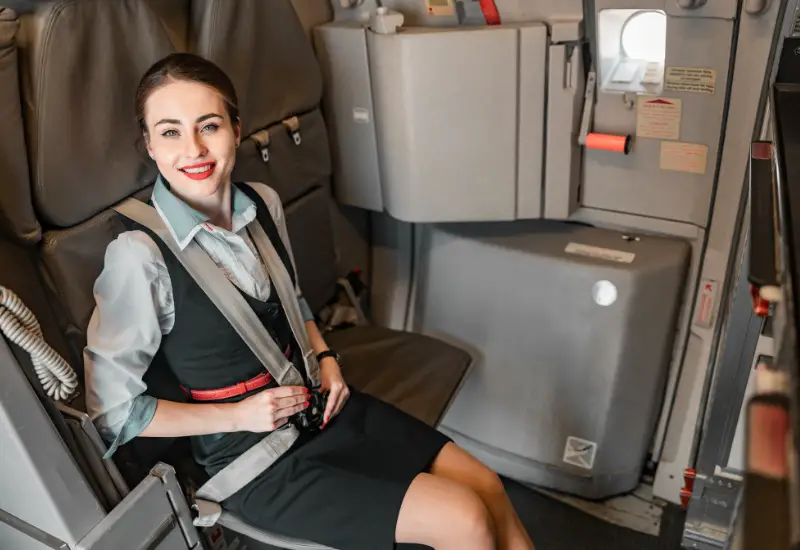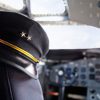Discover the essentials of a Flight Attendant jump seat in this concise guide. As a seasoned flight attendant with experience in three major US airlines, I’ll unravel the mysteries of jump-seating – explaining what it is, how to access it, and answering common questions.
🚨 Key Takeaways:
- Purpose: Jump seats in aircraft are for flight attendants and pilots, aiding in safety and emergency access.
- Access: Only certified crew can use jump seats. Active crew have assigned seats, while off-duty crew use extra seats based on availability.
- Request Process: Varies by airline, influenced by availability, aircraft balance, and sometimes seniority.
- Benefits and Challenges: Offers travel convenience for crew, but securing a seat can be competitive.
- Regulations: Governed by FAA and airline rules, with specific etiquette for attire and conduct.
What Is a Jump Seat on an Aircraft?
In aviation, the term “jump seats” is commonly used to refer to the seats occupied by flight crew members. These seats are often foldable and designed to be compact to maximize space.
Each Flight Attendant, working a flight, has a designated jump seat that they are mandated to occupy.
Then, there are also the Flight Attendants/Pilots who utilize these jump seats to non-rev (flying stand-by) from one destination, to another. There are also jump seats in the flight deck, which pilots/and a few other individuals are allowed to utilize.
Regular passengers are not allowed to occupy any of these seats, at any time.
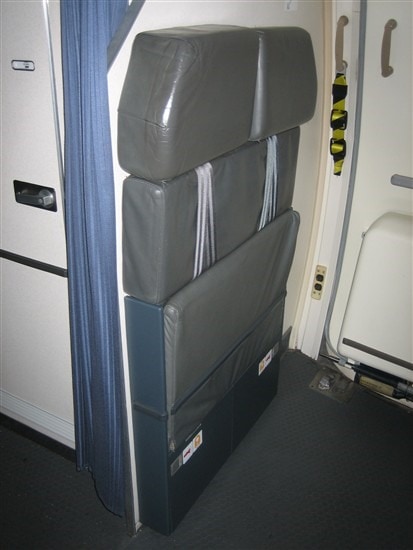
Purpose of a jump seat
The purpose of jump seats is to: give working crew access to their emergency doors, which we are required to be able to access quickly, have easy access to emergency equipment, in case other situations arise, and it gives us the ability to see the cabin clearly, during all phases of flight.
Jump seats are essential to being able to do our flight attendant jobs, including being able to protect the flight deck, in proper positions for take-off and landings, being able to provide a service, access to equipment and emergency doors, view of the entire cabin, a safe place to sit if there is turbulence, etc. Safety is our number one priority, and these jump seats ensure that we are able to accomplish that.
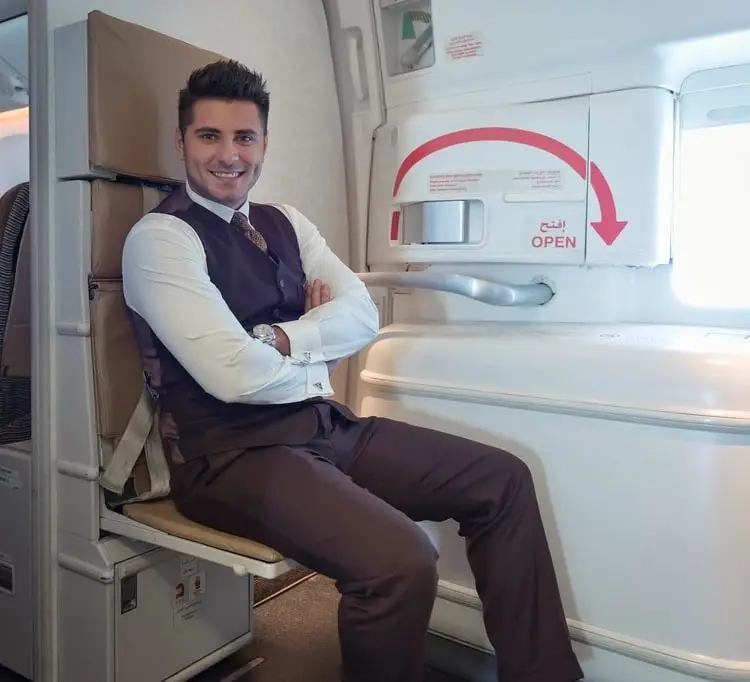
How to Access the Flight Attendant Jump Seat?
Jump seat access is extremely exclusive:
- To occupy Flight attendant jump seats you need to be a certified Flight Attendant. Of course, working crew, for the designated airline, are assigned specific jump seats, which are to only be occupied by those working individuals.
- To occupy Extra jump seats, you need to be an active Flight Attendant who has listed for a jump seat. They would occupy these seats, when there are no other open seats on the plane. These are primarily utilized for Flight Attendants who are commuting to-and-from work, or who are non-revving for other purposes.
Most airlines, in the U.S., only allow their own active Flight Attendants the privilege of being able to list for these seats.
**As for the pilots/dispatch, they are allowed to list for their own specific jump seats in the flight deck. They have their own process for this, but you will see other airline pilots being able to jumpseat on other airlines as well.
Process of requesting a jump seat
The process of requesting the jump seat differs between airline companies. My prior airlines, all you had to do was list for a seat on our specific travel page, check-in 24 hours prior to departure, and pray that you were high enough on the list to get a potential seat, if not, you were the number 1, or number 2 jump seater on the list.
Some airlines also give their employees a specific number of passes that are considered higher priority. You would only want to use this if you really needed to get to work, or home, and you saw that you were on the bottom of the list, with other jump seaters ahead of you. Other airlines, you need to list for the jump seat at the gate, and you need to do this an hour prior to departure. It is really dependent on the company.
Factors Influencing Access to Airline Jump Seats: Availability, Weight and Balance, Seniority
Factors that could influence access to these jump seats are availability. As stated above, there are only a certain amount of extra jump seats, depending on the type of aircraft.
It is always amazing when there are extra seats on the plane, then you don’t have to worry about needing to take the jump seat, but with planes being so full lately, if you need to take this jump seat, you have to ensure that you are one of, if not the first, jump seater checked in.
There is also weight and balance issues that could come into play. If this becomes the case, that specific flight, they would not allow any jump seater on that flight.
Also, some airlines do go based off of seniority. You could technically be the first jump seat on the list, but if another Flight Attendant decides they want to take that flight, and they have more seniority than you, they would take that position. Most airlines have stopped using this process, and it now goes off of when you check in, but know that this could be the case.
Benefits and Challenges of Jump Seating
There are a lot of benefits that come with having access to jump seat privileges, especially when it comes to traveling.
So many flights are going out full, that you really need these benefits to be able to get to where you are trying to go. This is especially important for Flight Attendants and pilots who are commuting back and forth to work.
The challenges of jump seating are making sure that you are at the top of the priority list for the jump seat. This can require you to check in for your flight, right on, the 24-hour mark. Or, making sure you are the first one to the gate to list for these seats. There have been plenty of times when this didn’t happen, and it took a lot of tries to get to where I needed to be.
Or, have to stay an extra day in the location I am at. This does also give you the opportunity to meet more of your fellow employees, especially if you are having to share space with one another.
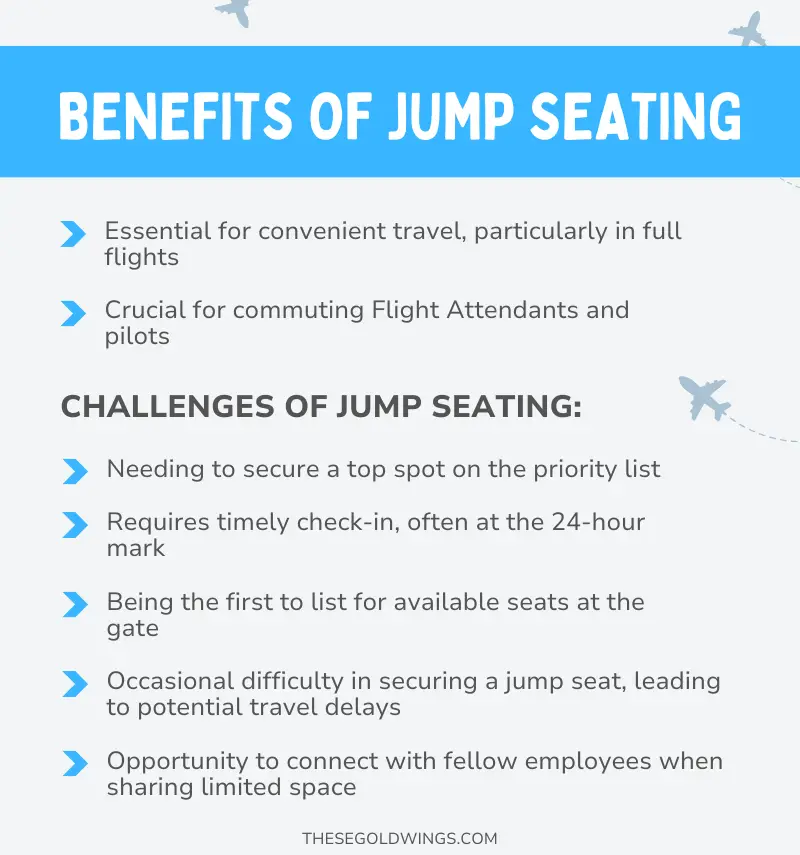
Frequently Asked Questions
➡️ Can passengers use a jump seat?
Passengers are not allowed to use a jump seat. These seats are only available for working Flight Attendants, non-revving active Flight Attendants, or pilots/dispatch taking an extra jump seat in the flight deck.
This is truly due to safety purposes. They are imperative to being able to conduct a safe flight, and ensures that active and qualified Flight Attendants/Pilots are the only ones who are permitted to sit in.
➡️ Are Flight Attendants required to use jump seats?
Working crew are required to occupy their designated jump seats. This is mandated and must be occupied for every take-off and landing.
Of course, they are able to leave these jump seats while doing their working duties.
As for non-revving Flight Attendants, if there is an extra seat available in the cabin, they will take these first, before having to sit on an extra jump seat.
All Flight Attendant regulations are mandated by the Federal Aviation Administration. Every Flight Attendant must go through a Federally mandated program in order to be qualified to be a crew member.
➡️ How many jump seats are there on a typical aircraft?
Each plane type will have different jump seat configurations, especially in regard to how many passengers that plane is going to hold.
On the typical aircraft, such as a 737-800, you will normally find two extra jump seats. All-together, there are six jump seats. Four of which would be occupied by the working flight crew.
However, this can change depending on the aircraft, the different configurations, and company.
Some airlines have the same types of aircraft, but they have more seats onboard. This would change how many jump seats are onboard.
➡️ Is there a specific etiquette for using the jump seat?
You will typically find that you should introduce yourself to the flight deck, the working Flight Attendants, and dress in appropriate attire.
Some airlines are extremely strict on what you can, and what you cannot wear while occupying a jump seat.
I would advise looking into each airline’s stipulations, this goes for non-revving on other carriers as well.
If you are flying standby, you are an ambassador for your company. You need to be on your best behavior. These benefits are a privilege and could be taken away, if you don’t conduct yourself appropriately.
➡️ Can Flight Attendants or pilots use a Flight Attendant jump seat for personal use or vacation?
Active Flight Attendants, on their respective carriers, can utilize the jump seat for personal use, or vacation. Pilots are allowed to utilize other carriers but sit in the flight deck where they have extra jump seats of their own.
If a Flight Attendant from another carrier wants to non-rev on another carrier, they can list for standby, but they have to sit in an available passenger seat.
They do not have the necessary qualifications, for that specific carrier, to have the ability to sit on one of their extra jump seats.
➡️ Are Flight Attendants allowed to use a jump seat on another airline?
Here in the U.S., they are not allowed to use a jump seat on another airline. This is due to the fact that they do not know the proper commands if there were to be an emergency, as well as giving their own employees the opportunity to utilize these benefits, and not have to worry about others trying to take those seats.
➡️ Can a Flight Attendant use a jump seat on a long-haul flight?
Yes. If they are an active Flight Attendant, they can jump-seat, on their own carriers, for long-haul flights. Although being on a small jump seat for a long-haul flight would not be ideal, they are allowed to do so.
➡️ Can Flight Attendants use the crew rest beds?
Only working crew members are allowed to use the crew rest beds. This is for safety and security purposes.
➡️ What’s the difference between buddy passes and Flight Attendant jump seats?
Buddy passes are given to active employees and can be given to family/friends/etc. This is on a standby basis and is only for empty passenger seats in the cabin.
Employees are usually given a designated amount of buddy passes per year that they can utilize.
Jump seat access is unlimited and is not considered a buddy pass.
Conclusion
Jump seats are designated as crew member seats, which can be utilized for working crew members, or active Flight Attendants and Pilots, who have access to extra jump seats, when available.
Each airline has their own policies and procedures when it comes to occupying these jump seats, but they give us the ability to do our duties, as well as get to the destination of our choosing.
